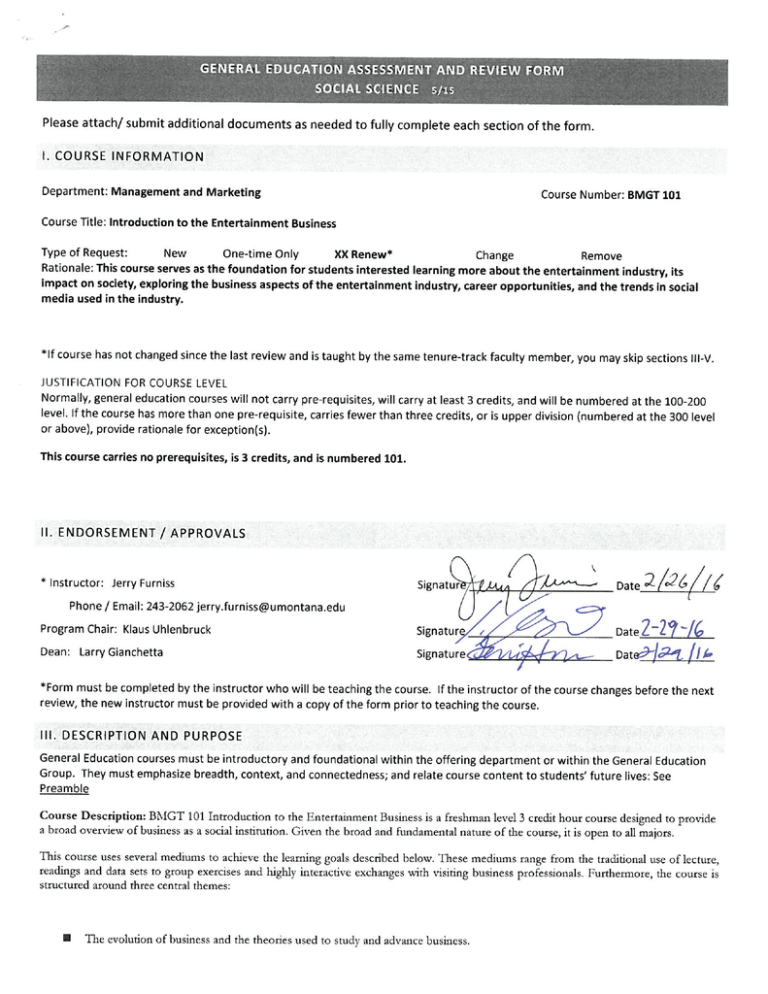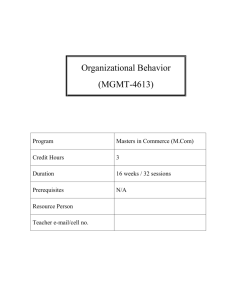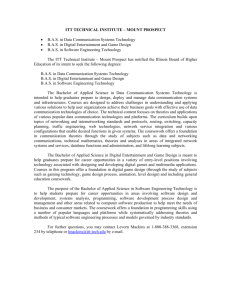Please attach/ submit additional documents as needed to fully complete... Rationale: This course serves as the foundation for students interested...
advertisement

GENERAL EDUCATION ASSESSMENT AND REVIEW FORM SOCIAL SCIENCE 5/15 Please attach/ submit additional documents as needed to fully complete each section of the form. I. COURSE INFORMATION Department: Management and Marketing Course Number: BMGT 101 Course Title: Introduction to the Entertainment Business Type of Request: New One-time Only XX Renew* Change Remove Rationale:Thiscourseservesasthefoundationforstudentsinterestedlearningmoreabouttheentertainmentindustry,its impact on society, exploring the business aspects of the entertainment industry, career opportunities, and the trends in social media used in the industry. *lf course hasnot changed sincethe last review and istaught bythe sametenure-track faculty member, you mayskip sections 111-V. JUSTIFICATIONFOR COURSE LEVEL Normally, general education courses will not carry pre-requisites, will carry at least 3 credits, andwill be numbered at the 100-200 level. Ifthe course has more than one pre-requisite, carries fewer than three credits, or is upper division (numbered at the 300 level or above), provide rationale for exception(s). This course carries no prerequisites, is 3 credits, and is numbered 101. II. ENDORSEMENT/APPROVALS * Instructor: Jerry Furniss Signatur< Date 2/^//^ Phone/ Email: 243-2062 jerry. furniss@umontana. edu Program Chair: KlausUhlenbruck Signatur( Dean: Signature . Larry Gianchetta Date2-2^-/6 Dat8^^2_/Lfc Form must be completed by the instructor who will be teaching the course. Ifthe instructor of the course changes before the next review, the new instructor must be provided with a copy of the form prior to teaching the course. III. DESCRIPTION AND PURPOSE General Education courses must be introductory and foundational within the offering department or within the General Education Group. They must emphasize breadth, context, and connectedness; and relate course content to students' future lives: See Preamble CourseDescription:BMGT101Introductionto theEntertainmentBusinessis a freshmanlevel3 credithourcoursedesignedto provide a broad overview of business as a social institudon. Given the broad and fundamental nature of the course, it is open to all majors. This course uses several mediums to achieve the learning goals described below. These mediums range from the traditional use of lecture, readings and data sets to group exercises and highly interactive exchanges with visiting business professionals. Furthermore, the course is structured around three central themes: The evolution of business and the theories used to study and advance business. . Data collection, analysis, results and the use & assessment of these results for business. . Exploration and application of our knowledge of business to current practices and topics. Course Learning Goals: Given the broad and fundamental nature for BMGT 101, students should achieve the following goals upon successfully completing the course: Given the broad and fundamental nature for BMGT 101, students should achieve the following goals upon successfully completing the course; . Describe the nature, structure and historical development of basic theories that underpin humans and their social interactions and . reladonships with business; Demonstrate a fundamental knowledge of the language of business; . . Describe basicsocial science methods for collecting & analyzingdata. Demonstrate anability to assess andevaluate conclusions andgeneralizations basedon data. Course Objectives: BMGT 101 Introduction to the Entertainment Business will mtroduce students to basic social and economic theories underpinning business; introduce students to the basic processes for data collection and analyses; illustrate how data Is used to influence businessdecisionsandpracdces;allowstudentsto learningroupandindividualsetdngs;and,affordstudentsopportunitiesto engage seniorbusinessexecutivesto examinehowbusinessesusetheory,dataandrelatedfindingsto makedecisions,whilealsoencouraging students to formulate and ask complex questions that demonstrate their ability to engage in critical analyses of business decisions and practices. In short, the primary objecdve for this course is to introduce students to businesses as both social and global institutions. IV. CRITERIA BRIEFLY EXPLAIN HOW THIS COURSE MEETS THE CRITERIA FOR THE GROUP. 1. Systematically study individuals, groups, or social institutions; BMGT 101 is a freshman level course designed to provide a broad overview of business as a social institution. Accordingly, it examines how businesses interact and react to socioeconomic influences. Students in the course also examine how businesses organize,motivateand lead individualsandgroupsto achieveboth businessand socialobjectives. Earlyin the coursestudents will be introducedto the languageof businessand primarytheories underpinningthestudyof business.Laterinthe course studentswill return to thesetheorieson severaloccasionsto critically analyzetheirveracityandapplicationto current business practices. Students will also besystematically exposed to various datacollection methods and methods ofanalysisto help in their critical assessments (this Is discussed in more detail below). 2. analyze individuals, groups, or social problems and structures; and/or Duringthe coursestudentsare introducedto theoriesand relatedfindingson individual,groupandsocialstructures (inthis case business structures). Forinstance, students will be exposed to theories ofmotivation andtheories ofgroup development. Theywill also begiventhe chanceto interactwithvisiting professionalsto examinethe extentthatthesetheoriesare implemented intheworkplace. Moreover, students are required to critically analyzecurrent business practices asreported in various media and academic outlets that contrast theory and related findings with ongoing business problems (and often, with larger social implications), practices and decisions. 3. giveconsiderableattention to waysin whichconclusionsandgeneralizationsaredevelopedandjustifiedaswell asthe methods of data collection and analysis. Purposes for research, alternative forms of data collection, and various methods of data analyses are given considerable attention under the structure for the course as outlined in the syllabus. Specifically, students will be exposed to data collection methods, given a brief overview of alternative methods of analyses, and discuss the notions of validity and generalizeability. Armed with this knowledge, students will further analyze current business practices and engage visiting professionals about their use of research to make informed business decisions,while alsogaininginsightto the validity andgeneralizeabilityof research findings. V. STUDENT LEARNING GOALS BRIEFLYEXPLAIN HOW THIS COURSE WILL MEET THE APPLICABLELEARNINGGOALS. 1. Describe the nature, structure, and historical development of human behavior, organizations, social phenomena, and/or relationships; Students are exposed to the historical development of the language and the theories that underpin the study of business. They examine the significant changes to the nature and structure of businesses as they are influenced by larger socioeconomic factors on local and global scales. Moreover, students will engage visiting professionals with extensive careers to gain a better understandingof howbusinesspracticesanddecisionprocesseshavedeveloped overthe recent past(1960sforward), both domestically and globally. Students are also exposed to (and critically analyze) readings that capture the historical nature and fluid dynamics for business. 2. use theory in explainingthese individual, group, or social phenomena; and/or Early in the course students are introduced to primary theories underpinning the study of business (e. g., Maslow's Needs Theory, Expectancy Theory, and various theories of decision-making). Afterwards, students are given several opportunities to analyzethe literature (academicand practitioneroutlets) to gaina bettergraspofthe extenttheory is usedto developand implement business practices. Additionally, students are afforded several opportunities to engage visiting professionals in rich dialogueto examinethe extentthesetheoriesareappliedin contemporary businesssettings. Studentsarealsorequiredto research and develop "offer" letters required by the industry to put an event together and to contract with entertainment talent. This requires student to review supply/demand issues, pricing issues, entertainment trends, buying behavior, and social interaction with media related to an event. 3. understand, assess, and evaluate how conclusions and generalizations are justified based on data. This area is given considerable emphasis because it isa major portion of the later portion ofthe course after a foundation has been laid in the early portion ofthe course. Initially, studentsareinformed on howdataarecollectedandanalyzed.Next,they are introduced to the notions of validity and generalizability of findings. Then, throughout the course students are exposed to research findings and/or examine business practices that lend support to-or call into question-various aspects of theories that underpin the study of business. As a result of this process, students should come away with a greater understanding for assessing the validity and generalizability of research findings. Students should also come away with an enhanced understanding and appreciation for how businesses use data and related findings to make informed decisions, and the extent that these findings and related decisions are generalizable across business and socioeconomic contexts. VI. ASSESSMENT A. HOW ARE THE LEARNING GOALS ABOVE MEASURED? Describe the measurement(s) used, such as a rubric or specific test questions that directly measure the General Education learning goals. Please attach or provide a web link to the rubric, test questions, or other measurements used. 1. 3 Exams:Students must successfully complete 3 exams that cover key terms and concepts related to the historical developmentofthe languageandthe theoriesthat underpinthestudyof business.Theseexamscoverthe principlesof business in the context of entertainment. These exams cover the significant changesto the nature and structure of businesses astheyare influencedbysocietyandglobal influences.Specifically,the examsassessthe student'sgraspofthe historical development ofthe fundamental theories and language that underpin the study of business aswell asthe student's understandingofthe basicnatureandstructure ofbusiness.Theyalsocontainquestionsthatfocusonthe student'sgraspof the social science methods for collecting and analyzing data; and, on how conclusions and generalizations are drawn from this research. Lastly, these exams assess the student's understanding for how practitioners use research findings to make decisions that Inform business practices. 2. Critical Analyses of Contemporary Business Practices: Throughout the semester students are required to write (and be preparedto presentor discussin class)3 critical analysesbasedon informationpresented in the classroom aswell asbasedon relevant handoutsor articlesdesignedto dealwith currententertainment, business,andsocialtrends, suchasthe useofsocial media in the entertainment industry. One critical analysis assignment is the research and development of an offer letter to an artist for an engagement at a selected venue. Students are expected to use their knowledge of fundamental business theories described in class andthrough outside research (including the useofthe program's access to proprietary databases used bythe industry), to develop, write, and be prepared to present these critical analyses of these selected topics. These written assignmentswill beturned in byspecified duedatesandwill beformatted pertheassignment instructions, andgradedaccording to a specified rubric (see below). Students will be prepared to discuss their critical analyses in class. Students will receive feedback and an opportunity to submit a rewrite. Critical Analysis Grading Rubric EachCritical Analysis is worth 50 points. The 50 points will be divided and graded accordinglyto how well you execute the following: 30 points 10 Content:This includes staying on topic, answering any questions, providing credible sources |and meeting all requirements of critical analysis prompts. Bibliography: It is important to make sure that all sources are cited correctly in your paper and also| points in your bibliography. 5 points Effort: This includes making sure it is noticeable that you made an effort to do your best worl^ by reachingthe numberof pages requestedand usingthe properformatandstructure. 5 points Spelling and Grammar Sample Critical Analysis Question: Sample Critical Analysis Assignment This isa bigtime ofthe yearfor entertainment. Kickoffto the NFLseason, college Football, MTVvideo musicawards. Emmys (primetime television awards), Teen Choice Awards, and many more which are all major events that the entire nation is able to witness and participate in thanks to social media (SM). The role of SM as part of and surrounding these events hasgrown exponentially. Forthis assignment you are to choose an event and investigate how the event organizers, attendees, pundits, or general public have planned to incorporate SM at the event (or how it was incorporated ifyou choose an event that hasalready occurred). You are to source three articles that present some information in this regard and sharewith us your key findingsand personal analysis. Here aresome questions you can address: Whatwas/isthe type of SMwith the largest presence surrounding/at the event? WhowasusingSM... thefans,theeventattendees, theorganizers, the pundits?Whatwerethetypesofusesof SM (opinions, snickering, photo-bombing, etc. )? What are your views of the rise of SM at such events? Have you utilized SM to respond to these events? Where do you see the role of SM headed? What were some intelligent uses of SM? These are just some questions to get you thinking. You are not required to address each one, Any findings must be substantiated; general opinions should only be part of your analysis. This paper must be a minimum of two pages, 12 point font (Times New Roman), double-spaced. Don't be afraid to go over two pages just be sure to maintain some focus. Please do not turn in rambling thoughts and also give yourself plenty of time to make at least one edit before handing it in. Use MLA format to source your materials and include a bibliography. 3. Creation of Discussion Questions and Interactions with Visiting Experts: Throughout the semester students will be introduced to 5-8 visiting experts from the entertainment, media, and technology business sectors and will have the opportunity to interact with these business professionals in the classroom. Students are required to do advance research on each visiting professional and prepare three meaningful questions related to the speaker's background in the industry. These questions are graded based on relevancy to each speaker's specialty and are required to be grounded in the concepts covered in class. (Students are provided a sample of well thought out questions and poorly designed questions as a guide. This guide is used to assess students' grasp of the exercise. These instructions are found on the Moodle course page. ) The top 20 questions from students are then assembled to be used in class to facilitate the presentation and interactions. Time is left for students to ask questions and interaction is strongly encouraged. This provides students with a rare opportunity to engage speakers in a highly informed dialogue about their business, its practices and how they explicitly and/or implicitly use business theories and data to make informed decisions. Thus, the professionals are not in class to lecture students on business but rather to engage students in a rich dialogue that illustrates the extent that business practitioners rely upon basic theories of business and related research to make informed business decisions. The instructor acts as a facilitator for the discussions, and asks probing questions that link business theory, research and practice. The combination of student questions and the instructor's questions and responses results in a highly informed and value-added discussion. Major points covered by the visiting professionals are incorporated into the three exams 4. (described in 1 above). Attendance: Attendance is taken in class. 5. Final Grade: Total Available Course Points: 500 Exams:50ptsx3= ISOpts Critical Analyses: SOpts x 3 = ISOpts Attendance: lOOpts Questions for Speakers: lOOpts A General Education Assessment Report will be due on a four-year rotating cycle. You will be notified In advance of the due date. This will serve to fulfill the University's accreditation requirements to assess general education and will provide an opportunity to connect with your colleagues across campus and share teaching strategies. Items VI. B- D will be helpful in compiling the report. B. ACHIEVEMENTTARGETS [This section is optional. Achievement targets can be reported if they have been established.] Describethe desirable level of performance for your students, and the percentage of students you expected to achieve this: C. ASSESSMENT FINDINGS [This section is optional. Assessment findings can be reported if they are available.] What were the results/findings, and what is your interpretation/analysis of the data? (Please be detailed, using specific numbers/percentages when possible. Qualitative discussion of themes provided in student feedback can also be reported. Do NOT use course grades or overall scores on a test/essay. The most useful data indicates where students' performance was stronger and where it was weaker. Feel free to attach charts/tabtes if desired.) D. ASSESSMENT FEEDBACK [This section is optional. Assessment feedback can be reported if it is available.] Given your students performance the last time the course was offered, how will you modify the course to enhance learning? You can also address how the course could be improved, and what changes in the course content or pedagogy you plan to make, based upon on the findings. Please include a timeframe for the changes. VII. SYLLABUS AND SUBMISSION Please submit syllabus in a separate file with the completed and signed form to the Faculty Senate Office, UH 221. The learning goals for the Social Science Group must be included on the syllabus. An electronic copy of the original signed form is acceptable.


